The Armujo Swimming Pool
Friday, July 11, 2025
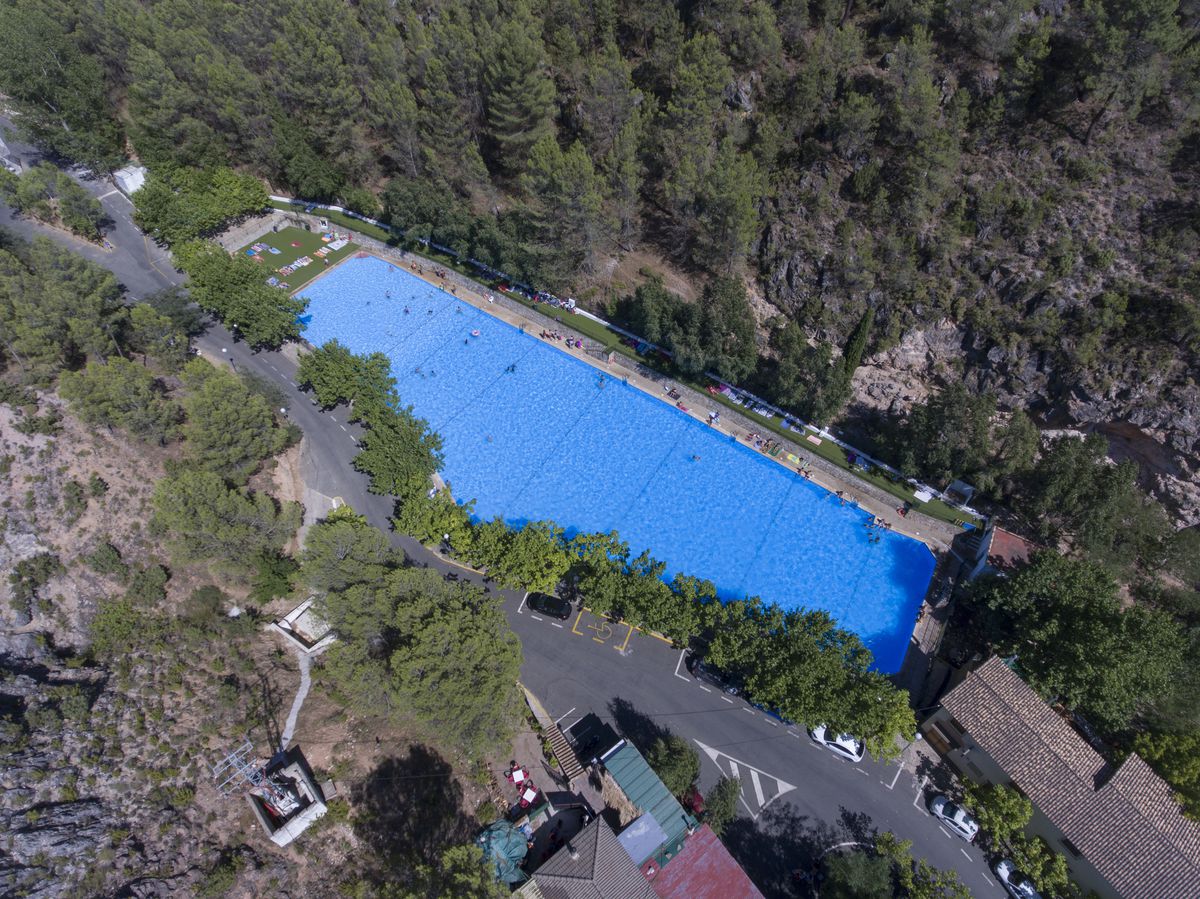
“From space, you can see the Great Wall of China, the Himalayas and also the Orcera pool”, says the lyrics of the song that the singer Zahara dedicated to the great Amurjo pool, in Orcera (Jaén), a huge backwater in which they fit four million litres of water, surrounded by pine trees and embedded in an idyllic natural setting.
Zahara Gordillo composed the song with the complicity of humorist David Broncano. The two met as children at the Orcera school —both their mothers were teachers there— and, years later, their paths crossed again to shout from the rooftops the benefits of what is already the most famous swimming pool in Spain and, in the absence of scientific verification, it may also be the largest. In addition, it is a pioneer in having a summer cinema where viewers enjoy the film lying on boats on this immense inland sea.
"I challenge everyone to come and take a long swim, it's amazing," says José Luis Endrino proudly, a young man from Orcero who goes almost daily to bathe in this large pond whose official measurements are 85 meters long by 30 wide. The operators take almost three days to fill it. Its capacity is for 1,200 people (just under the 1,700 inhabitants of this small municipality in the Sierra de Segura in Jaén), a figure that has meant that restrictions did not even have to be applied in the first two summers of the pandemic.
But this magical place has not always been like this. Until 1987 it was an area where the water from the Amurjo River was dammed. Subsequently, an agreement was signed with the Institute for the Conservation of Nature (ICONA) to divert the course of the river and turn this continental bathing area into a "blessed swimming pool", as is sung in the song by Zahara.
In some way, this inland ocean that represents the Amurjo pool serves as a metaphor for the greatness that this area once had, converted into a large reserve of the Spanish Navy. In Orcera, the Segura Common Ordinances were signed in 1580, a legal reference framework for almost 200 years until, in 1748, Fernando VI declared the so-called Segura Maritime Province (which included territories of Jaén, Albacete, Murcia and Ciudad Real). for the management of forest resources that were mainly used for shipbuilding. “Amurjo is something very special due to the connection with this space every summer. We speak of Amurjo with pride as one of the elements that identify us”, says Sergio Rodríguez, historian and official chronicler of Orcera.

"A pool like this, in the middle of such a beautiful natural setting, is a real luxury," remarks Clara Herreros, who goes daily with her two children to this "privileged place." This user highlights the accessibility and adaptability of Amurjo and the wide leisure-cultural offering that is generated around it. From the Summer School to the Multisport Campus, passing through the lifeguard courses, everything has its epicentre in this natural area, which since this summer is also the starting point for a tourist train. "It is clear that it is the flagship of tourism in the entire region, but at the same time it becomes an important source of local employment," says Sonia Romero, the councillor responsible for managing Amurjo. In addition to the dozen direct jobs created, the City Council has opened a job bank for young people looking for their first job, where they offer 15-day contracts for the maintenance tasks of this large pool that, as Zahara sings, seems to be “the bathtub of the gods”.
 
Finally one of the main attractions of this great aquatic complex is its peculiar summer cinema. The stage is set up in the water and viewers can watch the movies from the pool steps or by renting a boat to watch from the water. The films are usually related to the aquatic world and during the projection the lighting of the pool is played with, which changes colour offering spectacular effects.
 10
Like
Published at 10:05 PM Comments (0)
10
Like
Published at 10:05 PM Comments (0)
Best Beaches in Murcia
Saturday, June 14, 2025
There is no doubt that Spain has some fantastic beaches and Murcia has its fair share. The Region of Murcia is a Mediterranean area with a contrasting landscape from arid basins to wooded areas in the inland mountains, the meadows of the Segura River and the Mediterranean coastline. It is bordered by the province of Alicante, Granada, Almería and Albacete and finally to the south is where it meets the sea and we can find a string of idyllic beaches and coves.
If you are visiting the region be sure to check out some of the beaches:
These are some of the beaches in the Region of Murcia in no particular order:
1. Playa de Calblanque (Cartagena)
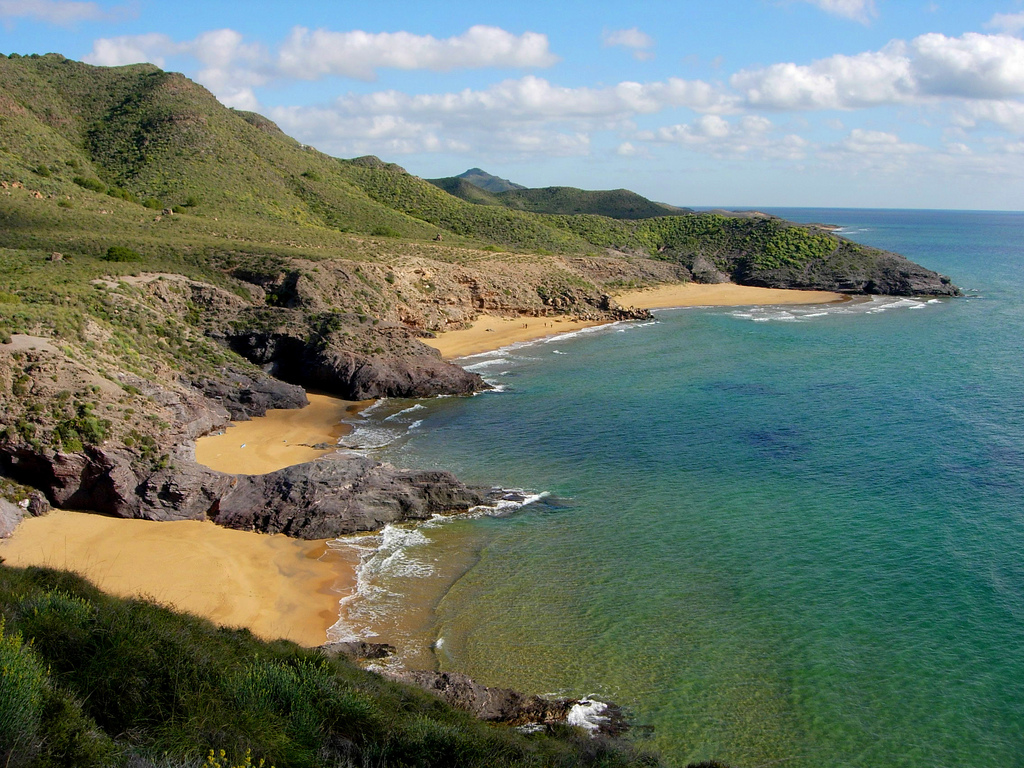
Ver mapa más grande
2. Playa de La Manga

Ver mapa más grande
3. Playa de los Cocedores del Hornillo(Águilas)
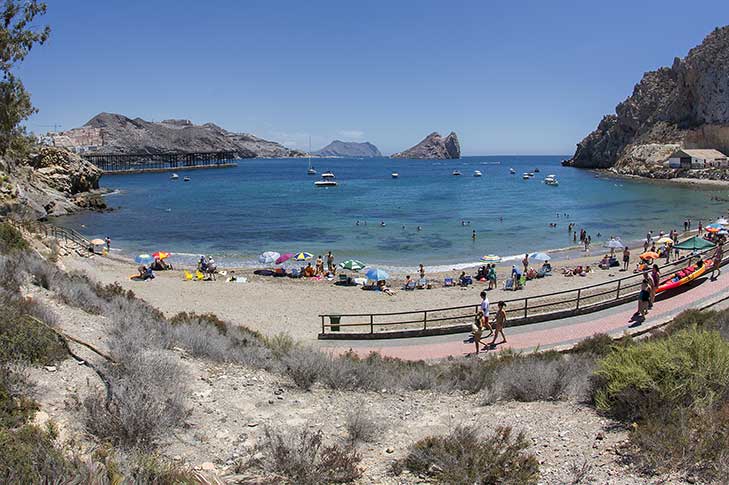
Ver mapa más grande
4. Playa de Bolnuevo (Mazarrón)

Ver mapa más grande
5. Playa de Estacio (San Javier)

Ver mapa más grande
6. Playa de Puerto de Mazarrón (Mazarrón)

Ver mapa más grande
7. Playa de La Llana (San Pedro del Pinatar)

Ver mapa más grande
8. Playa de El Portús (Cartagena)

Ver mapa más grande
9. Playa Mar de Cristal (Cartagena)

Ver mapa más grande
10. Cala Cortina (Cartagena)
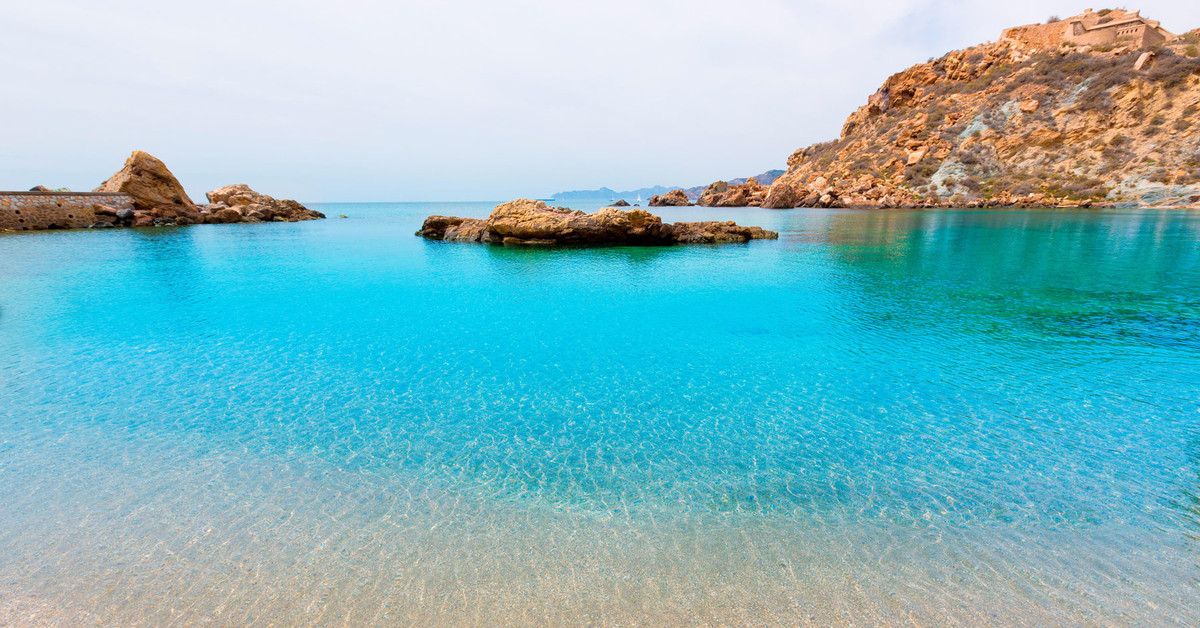
Ver mapa más grande
 1
Like
Published at 12:04 AM Comments (3)
1
Like
Published at 12:04 AM Comments (3)
10 Beaches to Discover this Summer in Spain
Friday, May 30, 2025
The Summer is nearly here and the beach is the number one destination this time of year. However most people tend to think of the south of Spain or the Mediterranean coastline is the best place to visit, but Spain has fantastic beaches in every corner of its landmass, here are 10 great beach destinations that can be enjoyed all year round whichever corner of the country you choose to visit.. (the list is in geographical order, more or less, so not in order of greatness!)
1. Playa de Rodas, islas Cíes
.jpg)
This beach joins the islands of Monteagudo and Faro on the archipelago of the Cíes Islands. Its fine, white sand and crystalline emerald waters bring delight to anyone who visits it and encourages bathers to confront the cold sea. Next to the beach there are natural dunes which are currently being recovered. You can spend the night in an idyllic campsite, located among large pine trees, with a beautiful ocean view.
2. Playa Torimbia, Llanes

It is one of the wildest and prettiest beaches in Asturias and is also well known for the great atmosphere provided by the people who visit it. Because it is a cliff, which makes it rather difficult to reach, when you see the beach from above you will be sure to want to climb down. Its white sand, stretching for nearly 500 metres, makes it look idyllic. It is very popular with nudists and also surf-lovers, thanks to the fierce waves caused by the wind in the area.
3. Playa de Mataleñas, Santander
.jpg)
This beach is very near Santander, between Cabo Menor and Cabo Mayor, and it owes its beauty to its location, surrounded as it is by high cliffs. Even though the beach is isolated, a great many people visit it during the summer, which is easy to understand since it is one of the best beaches along this coast. It is accessed on foot, by way of steep steps. Its waters are clean and it has a lovely seaside promenade from where you can enjoy some unbeatable views.
4. Cala Estreta, Palamós, Girona
.jpg)
A picture postcard cove, ideal for anchoring boats and enjoying the transparency of the sea, it is perfect for snorkelling and watching a large number of fish. Access is difficult because you can only reach the beach on foot or by bike (in summer cars are forbidden) There is some privacy and maybe for this reason it is popular with nudists. The beach is very narrow - which is how it came by its name [Estreta, meaning narrow] - and on many stretches it is no more than two metres wide.
5. Playa Macarella, Menorca
.jpg)
This virgin beach emerges in the midst of a thickly forested area, filling the Menorcans with pride and offering pure delight to visitors. Its crystalline waters are a real pleasure that invite bathers to switch off from everything and rest. You can visit several caves in the area, one of which is at the entrance to the cove called “Es Castell de Macarella”. Less than 500 metres away is Cala Macarelleta, just as pure and pretty but slightly smaller, which makes it even more charming.
6. Dénia, Alicante
.jpg)
These beaches and coves will surprise you with every step you take. They all hold international certificates for quality and environmental management; a real guarantee in the services offered. In addition, along the coast of Denia you can find numerous flora micro-reserves. For example, the Cabo San Antonio Marine Reserve is of notable interest: a protected area that possesses an ecosystem with great natural wealth, which can be discovered by means of several underwater routes (subject to prior permission).
7. Playa de Mazarrón, Murcia
.jpg)
A lot of sun, warm, calm blue waters and the good weather all year long make Mazarrón (Murcia) the ideal place for resting. You immerse yourself in its depths, lose yourself in its coves and feel the emotion of water sports. The 35 kilometres of coast in the region mean there are beaches that will satisfy everyone's taste, from crowded, urban beaches to hidden beaches in natural areas, where an air of solitude reigns.
8. Playa de los Muertos, Almería
.jpg)
Located at the northernmost end of the Cabo de Gata Natural Park – Níjar, it is a totally straight beach, as if it had been drawn with a ruler. It affords wonderful views and its waters are an amazing blend of bluesThere is also a small island which is regularly used by nudists. According to local belief, the colour is due to the whirlpools and currents of the water, so if you decide to visit it you must take care not to have a nasty surprise while you are bathing.
9. Playas del Cabo de Roche, Cadiz
.jpg)
A group of beaches that stand out for their coves, well known for their incredible sunsets. Each one has its own charm: on the one hand, there is Playa de los Bateles, a large, family beach with a seaside promenade, spectacular for its size and the quality of the sand. And, on the other, the jewel in the crown of this coast, the Playa de Castilnovo, which is practically virgin and with a wild appearance that is ideal for surfing. Considered to be a Place of Community Interest, it is a natural beauty spot with walking access to the estuary of the Salado river.
10. Playa del Papagayo, Lanzarote

It is one of the most spectacular beaches in the Canary Islands and is situated inside Los Ajaches Natural Monument. It is a stunningly beautiful cove sheltered by the cliff walls that surround it on both sides. You need to go well prepared to spend a day there: although it is easy to access, because it is some way from the nearest towns, there are few services around. Its golden sand and crystalline water will make you feel as though you are in paradise.
 0
Like
Published at 7:48 PM Comments (0)
0
Like
Published at 7:48 PM Comments (0)
Best Beaches from Castellón to Alicante
Thursday, May 15, 2025
Lying on the sand and enjoying the sun, diving into the refreshing waters of the Mediterranean, playing volleyball, taking a pedal boat out to sea, working out in one of the fitness areas, eating an ice-cream or taking a sailing course are just some of the activities you can enjoy on Valencia's endless beaches. Admittedly, Andalucia and Murcia has some wonderful spots but some of my favourites are to be found in the Valencian Community. Playa La Granadella tops the list because it is certainly my favourite in the region as I am not really a fan of sand and Granadella is a shingle beach. But the rest of the list is in no real order. So I hope this helps to show you around a little and maybe even gives you ideas for alternative places to visit when on holiday along the coast of Valencia.
1. Playa de la Granadella de Jávea (Alicante)



Ver mapa más grande
2. Playa Norte de Gandia (Valencia)

Ver mapa más grande
3. Playa de Levante de Benidorm (Alicante)

Ver mapa más grande
4. Playa del Portet de Moraira-Teulada (Alicante)

Ver mapa más grande
5. Playa Norte de Peñíscola (Castellón)

Ver mapa más grande
6. Playa de Cala del Penyal de Calpe (Alicante)

7. Playa de El Russo de Peñíscola (Castellón)

Ver mapa más grande
8. Playa de Canet d´En Berenguer (Valencia)

Ver mapa más grande
9. Playa de Els Terrers de Benicàssim (Castellón)

Ver mapa más grande
10. Playa de la Concha de Oropesa del Mar (Castellón)
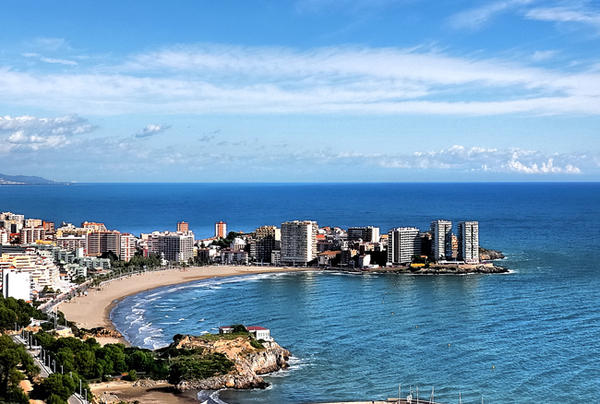
Ver mapa más grande
 0
Like
Published at 12:01 AM Comments (0)
0
Like
Published at 12:01 AM Comments (0)
The Most Beautiful Villages in Navarra
Saturday, May 10, 2025
Navarra has some of the most beautiful villages in the country, not often a region that foreigners really think of visiting, but it really must be considered as there is so much to see. Here are 10 of the most beautiful villages worth visiting...
1. Olite
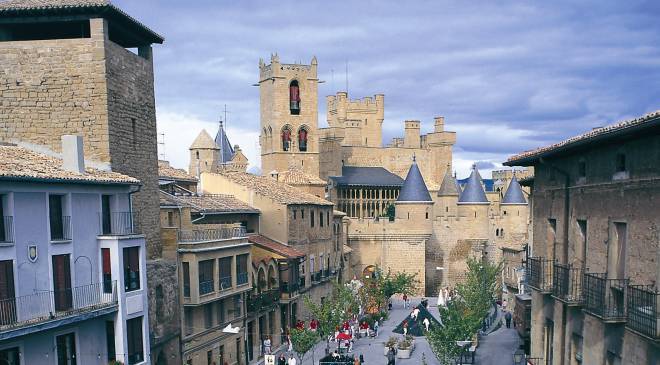
The sleek and harmonious silhouette of the Castle-Palace stands out against the skyline of Olite, a small town in the centre of Navarre just 42 kilometres south of Pamplona that was the seat of the Royal Court of the kingdom in the Middle Ages. The thick walls and crenelated towers of the Palace were home to monarchs and princes. Declared a national monument in 1925, it is the best example of civil Gothic architecture in Navarre and one of the most notable in Europe.
A walk through the narrow streets of Olite will take you past noble stone houses with coats or arms on their facades and grandiose wooden eaves, mediaeval galleries and splendid churches, and the Roman wall surrounding the town. Its Mediterranean climate has also made Olite a wine capital. Visit its bodegas (wineries) and try their wines. Let yourself be guided, the town will take you back to an era of tournaments, kings and princesses, wizards and jugglers, falconers and archers; they all return to Olite every August for a Mediaeval Fair.
2. Roncesvalles
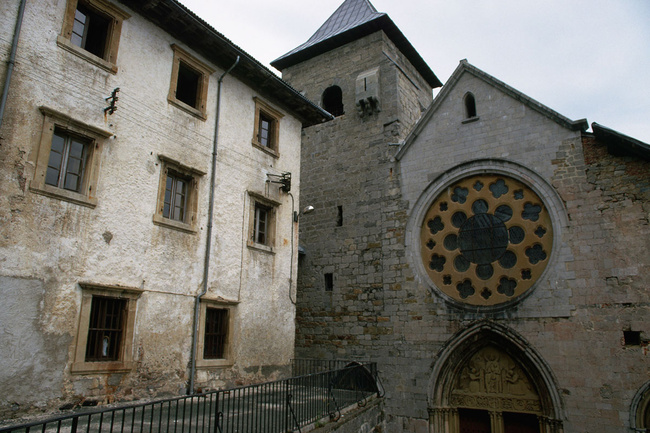
The collection of the historic buildings in Roncesvalles, located in the westernmost side of the Pyreneen mountain range, are erected on the bottom of the southern slope of the Ibañeta hill and near the wide plain of Auritz- Burguete.
A place for the pilgrims to rest after the rough ascent from the lower Navarre valleys, "The Collegiate church of Santa María de Roncesvalles" is surrounded by some mountains like: Astobiskar (1266 m.) and Ortzanzurieta ( 1570 m), distinguished because they are the oldest territories of Navarra, more than 450 million years old.
3. Puente La Reina

Puente la Reina, "the crossroads of the ways", is a medieval town where the two main routes on the Pilgrim's Way to Santiago de Compostela converge. It is one of the enclaves with the greatest affinity with Compostela in Navarre. The constant transit of pilgrims, the scallop shells and the walking sticks all form part of the urban landscape of this town, a magnificent example of a "street-based" town just 24 kilometres south-west of Pamplona.
Walking along the narrow Rúa Mayor is a very pleasant exercise that allows you to discover architectural gems such as the churches of the Crucifix, St. James and St. Peter and beautiful buildings peppered with details of the influence of the Pilgrim's Way. However, there is no doubt that the Romanesque bridge across the river Arga is the most amazing sight of all. It is one of the most beautiful and distinguished examples of Romanesque architecture on the way to Santiago and is what gives its name to this town of barely 2,500 inhabitants.
4. Ujué

Lost up on the heights of a plateau with no rivers to refresh it and no trees to shelter it, seemingly intoxicated with its solitude, stands Ujué, a delightful medieval village of narrow streets that climb steeply upwards to reach, at the top, the Sanctuary-Fortress of Santa Maria de Ujué. Located in the Central Zone, Ujué is one of the most important places of worship in Navarre and a spectacular lookout point over the Pyrenees and riverside plains.
The Sanctuary, a national monument, is one of the most important examples of medieval architecture in Navarre, and is at the centre of a beautiful legend. On your journey, lose yourself in the maze-like layout of this tiny village of just 300 inhabitants; stroll slowly along its cobbled streets and don't miss the opportunity to try the delicious migas de pastor ('shepherd's breadcrumbs'). There are very few places that make them like they do in Ujué.
5. Elizondo

Elizondo, the capital of the Baztan valley, will amaze you with its numerous mansion houses and palaces. Its most emblematic building is the Baroque palace of Arizkunenea, but there are also other monuments of artistic interest such as the town hall, the Datue Palace, the Viceroy's house and the church of Santiago. Set in idyllic natural surroundings, the hustle and bustle that typify Elizondo have made this locality the valley's inhabitants' favourite place for holding fairs and markets.
One of the most long-standing traditions is the Baztandarren Biltzarra, a festival of colourful dances and processions that brings together all the villages in the valley. On your visit to Elizondo, be sure to try its famous urrakin egina (chocolate with whole hazelnuts). Elizondo lies at the geographical and nerve centre of the Baztan valley . Located in the north of Navarre, the valley encompasses fifteen towns within its municipal boundaries, which are dotted throughout the luxuriant green landscape of the Atlantic Pyrenees.
6. Sanguësa

A border post on the Pilgrim's Way and a hospitable and monumental town, Sangüesa is a mixture of the mountains and the plains, a place to see and experience. Located 44 kilometres from Pamplona and with a population of just over 5,000, the most important town in medieval Navarre is well known thanks to the Pilgrim's Way to Santiago de Compostela and its architectural treasures, particularly the facade of the church of Santa María, a superb example of Romanesque architecture that has been declared a National Monument. Its interesting civil buildings, churches and convents evoke epochs of splendour and reveal a town that is very closely linked to its traditions.
On January 6th every year the Auto Sacramental de los Reyes Magos (allegorical religious play about the Three Wise Men) takes place, one of the five that has been conserved in Spain. Stroll through the old streets of Sangüesa and stop to take a look at every one of its splendid buildings; take part in its medieval traditions and try its famous pochas (succulent white beans). In a land of transition between the first peaks of the Pyrenees and the plains along the river Ebro, Sangüesa stands on the banks of the river Aragón on slightly raised ground in the eastern part of the Central Zone of Navarre, 44 kilometres from Pamplona.
7. Artajona

A magnificent medieval fortification crowns the top of the hill on which Artajona stands, a small village 30 kilometres from Pamplona which invites you to close your eyes and step back into a past inhabited by monarchs, noblemen, bishops and popes. This stunning eleventh-century fortress, known as "El Cerco", rises up imposingly over the village that descends down the slopes to the plain in a maze of narrow, cobbled streets, marked along the way by monumental houses and palaces.
On your journey you will discover a town of 1,700 people which, as well as "El Cerco", still preserves other buildings of interest such as eighteenth-century palaces, the Gothic church of St. Peter and, on the outskirts, the basilica of Our Lady of Jerusalem and the chapel of St. Bartholomew. You can also discover why its bells and the "fork and sickle race" are so important. The walls of Artajona, a small town in the Central Zone halfway between Puente la Reina and Tafalla, conceal a wealth of history that will take you back to the Middle Ages, times of territorial conquest and marriages of convenience when the town became the wedding present of King García Ramírez to his wife, Lady Urraca.
8. Estella - Lizarra

Half way between Pamplona and Logroño, in an area between the mountains and the plains, lies Estella, a historic city that came into being when pilgrims were travelling along the Pilgrim's Way to Santiago de Compostela in large number. In the 15th century it was known as "Estella the elegant" and to the present day it continues to live up to this epithet. It is a romantic city that places great value on its palaces, stately homes, churches, convents, bridges and beautiful buildings, which have earned it the nickname of the "Toledo of the North".
The city of 13,000 inhabitants will surprise you with its flourishing commercial life and bustling Thursday market, its passion for music and theatre, as well as its impeccable cuisine. Strolling through the city you will pass pilgrims and visitors eager to explore the old streets of the Franks and the Jews and see proof that the phrase coined by Aymeric Picaud is as true today as it was in the 11th century: "Estella is a city of good bread, excellent wine, much meat and fish and all kinds of pleasures."
9. Ochagavia

Ochagavía is the perfect photograph, the one that always looks right; the day or the light conditions do not matter. It is the picture postcard of the Pyrenees of Navarre, with its cobbled streets, its well-kept houses with steep roofs and the river with an old mediaeval bridge crossing it. The stone church, crowned by a robust and elegant tower, is an interesting perspective that breaks up the skyline. A landscape of high mountain peaks and dense forests complete the image, in which the very ancient dances in honour of the Virgin Mary of Muskilda must be present.
The town of Ochagavía is located 764 metres above sea level at the northernmost point of the Pyrenean valley of Salazar, in north-east Navarre. Surrounded by high peaks and beech and Scots pine forests, it is one of the most picturesque places in the Navarrese Pyrenees thanks to the architecture of its caseríos (large houses) and its location at the confluence of the Zatoia and Anduña rivers, which join here to form the river Salazar.
10. Amaiur/Maya

A picturesque one-street village that receives the visitor with its peculiar entry arch. The people built their houses along the route of the Pilgrims' Way in the Baztan valley. The lack of alignment and uniformity of the façades avoids monotony and leads to some excellent perspectives. The characteristic reddish colour of the stone from the quarries at Almándoz impregnates, as in the rest of the Baztan valley, its houses.
Noble house architecture has left some magnificent examples in the village, such as Palacio Arretxea or Casa Arriada, where council meetings were held in the 16th century. One of the most emblematic spots in Amaiur/Maya is located at the entry to the village. It is a restored mill that still operates, and where visitors can buy corn or wheat flour or taste recently baked talos, fine corn flour pancakes that are eaten with other products such as cheese, chocolate, or chistorra (spicy sausage).
 0
Like
Published at 12:06 AM Comments (0)
0
Like
Published at 12:06 AM Comments (0)
My Favourite Beaches around Spain
Friday, May 2, 2025
Spain's coastline is peppered with spectacular beaches and I most certainly haven't visited them all...but here are my favourite beaches to date! Why not share your favourite ones in the comments section!
1. Es Talaier (Ciudadela, Menorca)

After a 15-minute walk from Son Saura, everything conspires to push the traveller into this voluptuous pool of translucent waters that shine under the bright sun. Its pine groves are seductive like snake’s eyes, and the beach is free of tourist boats.
2. Cala Fonda, Waikiki (Tarragona)

The proximity of a petrochemical compound only underscores the value of this Mediterranean relic. It is necessary to park at the restaurant Mirall d’Estiu, on Larga beach, and walk for two kilometers. The pine groves then give way to an uncomfortable final stretch before the actual beach is reached. Some walk about in the nude, others go for a swim. Everyone talks wonders about this place.
3. Escorxada and Fustam (Es Migjorn Gran, Menorca)

Water taxis were created for those who dislike walking. Taximar (www.menorcataximar.com), based in Cala Galdana, organizes trips to the remote coves of Escorxada and Fustam, with stops at Trebalúger and a couple of sea caves. The parasol-and-cooler-carrying traveler can then choose a beach to enjoy for the next five hours, until pick-up time. The cost of the service is €25.
4. La Granadella (Xàbia, Alicante)

There is nothing quite like enjoying the majestic Mediterranean early in the morning outside high season, and to practice your swimming strokes as you listen to the rhythmic sound of the pebbles being swept by the waves. Sur restaurant (www.restaurantesur.com) has its own boat and vegetable garden.
5. Melide (Cangas de Morrazo, Pontevedra)

To say Melide is to evoke the Cíes islands: there are only three kilometers separating Melide from the national park, and no need to stand in line at the ship docks. Both share a creamy-colored sand, freezing waters and loads of pine trees. Its remote location ensures that the masses stay away. A foot trail begins in Donón and ends in Punta Subrido, home to Pedro Piñeiro’s beach bar.
6. Playazo de Rodalquilar (Níjar, Almería)

Located inside Cabo de Gata, this is a crowded beach (access is easy) but its sand is a joy to behold, and it is set against a cliff of such a pale yellow as to appear white. It was the filming location for the 2015 movie ‘Lejos del mar’ (or, Far from the sea), by Imanol Uribe. The Los Patios hotel is nearby (www.lospatios.net). It is a good idea to walk the 1.4 kilometer trail from San Ramón castle to Cuervo cove.
7. Güí-Güí (La Aldea de San Nicolás, Gran Canaria)

This is the beach at the end of the (Canary Islands) world. The two-and-a-half hour mountain trek from Tasartico is worth it (remember to bring at least two liters of water per trekker). Anyone who makes it to these two strips of sand with views on Mount Teide should be eligible for a certificate of achievement.
8. Aigua Xelida (Palafrugell, Girona)

The pungent smell of the pine grove, its narrow shape, the fact that the nearby residential estate is nearly unnoticeable... Everything conspires to make us disconnect from the outside world. A plaque on the fisherman’s shack reminds visitors about the times when the writer Josep Pla spent time here, drawing inspiration from the coastline and the wind to write about a legendary, extinct Costa Brava that we may nevertheless explore in kayaks (www.kayakingcostabrava.com) from the homebase of Tamariu.
9.Xarraca (Sant Joan, Ibiza)

This cove in northern Ibiza is located next to the road, and its waters are of an arresting turquoise color. This is a pebble beach, meaning that it is good for snorkeling and paddle boats. Rising up from the water near the shore is Penya Grossa, a rock that doubles as a diving board, and the nearby Penya Petita, a small reef where swimmers stop for a break.
10. Barayo (Valdés / Navia, Asturias)

Anyone approaching Barayo from Navia will be treated to one of the parking lots with the most sublime views on the Cantabrian coast: salt flats, marshes, dunes, tall grass and cane fields, pine trees and eucalyptus on a cliff.
 3
Like
Published at 11:46 PM Comments (2)
3
Like
Published at 11:46 PM Comments (2)
The Best Beaches along the Coast of Valencia-Alicante
Friday, April 25, 2025
Lying on the sand and enjoying the sun, diving into the refreshing waters of the Mediterranean, playing volleyball, taking a pedal boat out to sea, working out in one of the fitness areas, eating an ice-cream or taking a sailing course are just some of the activities you can enjoy on Valencia's endless beaches. Admittedly, Andalucia and Murcia has some wonderful spots but some of my favourites are to be found in the Valencian Community. Playa La Granadella tops the list because it is certainly my favourite in the region as I am not really a fan of sand and Granadella is a shingle beach. But the rest of the list is in no real order. So I hope this helps to show you around a little and maybe even gives you ideas for alternative places to visit when on holiday along the coast of Valencia.
1. Playa de la Granadella de Jávea (Alicante)



Ver mapa más grande
2. Playa Norte de Gandia (Valencia)

Ver mapa más grande
3. Playa de Levante de Benidorm (Alicante)

Ver mapa más grande
4. Playa del Portet de Moraira-Teulada (Alicante)

Ver mapa más grande
5. Playa Norte de Peñíscola (Castellón)

Ver mapa más grande
6. Playa de Cala del Penyal de Calpe (Alicante)

7. Playa de El Russo de Peñíscola (Castellón)

Ver mapa más grande
8. Playa de Canet d´En Berenguer (Valencia)

Ver mapa más grande
9. Playa de Els Terrers de Benicàssim (Castellón)

Ver mapa más grande
10. Playa de la Concha de Oropesa del Mar (Castellón)

Ver mapa más grande
 2
Like
Published at 9:40 PM Comments (0)
2
Like
Published at 9:40 PM Comments (0)
Most Beautiful Villages in Navarra
Saturday, March 15, 2025
Navarra has some of the most beautiful villages in the country, not often a region that foreigners really think of visiting, but it really must be considered as there is so much to see. Here are 10 of the most beautiful villages worth visiting...
1. Olite

The sleek and harmonious silhouette of the Castle-Palace stands out against the skyline of Olite, a small town in the centre of Navarre just 42 kilometres south of Pamplona that was the seat of the Royal Court of the kingdom in the Middle Ages. The thick walls and crenelated towers of the Palace were home to monarchs and princes. Declared a national monument in 1925, it is the best example of civil Gothic architecture in Navarre and one of the most notable in Europe.
A walk through the narrow streets of Olite will take you past noble stone houses with coats or arms on their facades and grandiose wooden eaves, mediaeval galleries and splendid churches, and the Roman wall surrounding the town. Its Mediterranean climate has also made Olite a wine capital. Visit its bodegas (wineries) and try their wines. Let yourself be guided, the town will take you back to an era of tournaments, kings and princesses, wizards and jugglers, falconers and archers; they all return to Olite every August for a Mediaeval Fair.
2. Roncesvalles

The collection of the historic buildings in Roncesvalles, located in the westernmost side of the Pyreneen mountain range, are erected on the bottom of the southern slope of the Ibañeta hill and near the wide plain of Auritz- Burguete.
A place for the pilgrims to rest after the rough ascent from the lower Navarre valleys, "The Collegiate church of Santa María de Roncesvalles" is surrounded by some mountains like: Astobiskar (1266 m.) and Ortzanzurieta ( 1570 m), distinguished because they are the oldest territories of Navarra, more than 450 million years old.
3. Puente La Reina

Puente la Reina, "the crossroads of the ways", is a medieval town where the two main routes on the Pilgrim's Way to Santiago de Compostela converge. It is one of the enclaves with the greatest affinity with Compostela in Navarre. The constant transit of pilgrims, the scallop shells and the walking sticks all form part of the urban landscape of this town, a magnificent example of a "street-based" town just 24 kilometres south-west of Pamplona.
Walking along the narrow Rúa Mayor is a very pleasant exercise that allows you to discover architectural gems such as the churches of the Crucifix, St. James and St. Peter and beautiful buildings peppered with details of the influence of the Pilgrim's Way. However, there is no doubt that the Romanesque bridge across the river Arga is the most amazing sight of all. It is one of the most beautiful and distinguished examples of Romanesque architecture on the way to Santiago and is what gives its name to this town of barely 2,500 inhabitants.
4. Ujué

Lost up on the heights of a plateau with no rivers to refresh it and no trees to shelter it, seemingly intoxicated with its solitude, stands Ujué, a delightful medieval village of narrow streets that climb steeply upwards to reach, at the top, the Sanctuary-Fortress of Santa Maria de Ujué. Located in the Central Zone, Ujué is one of the most important places of worship in Navarre and a spectacular lookout point over the Pyrenees and riverside plains.
The Sanctuary, a national monument, is one of the most important examples of medieval architecture in Navarre, and is at the centre of a beautiful legend. On your journey, lose yourself in the maze-like layout of this tiny village of just 300 inhabitants; stroll slowly along its cobbled streets and don't miss the opportunity to try the delicious migas de pastor ('shepherd's breadcrumbs'). There are very few places that make them like they do in Ujué.
5. Elizondo

Elizondo, the capital of the Baztan valley, will amaze you with its numerous mansion houses and palaces. Its most emblematic building is the Baroque palace of Arizkunenea, but there are also other monuments of artistic interest such as the town hall, the Datue Palace, the Viceroy's house and the church of Santiago. Set in idyllic natural surroundings, the hustle and bustle that typify Elizondo have made this locality the valley's inhabitants' favourite place for holding fairs and markets.
One of the most long-standing traditions is the Baztandarren Biltzarra, a festival of colourful dances and processions that brings together all the villages in the valley. On your visit to Elizondo, be sure to try its famous urrakin egina (chocolate with whole hazelnuts). Elizondo lies at the geographical and nerve centre of the Baztan valley . Located in the north of Navarre, the valley encompasses fifteen towns within its municipal boundaries, which are dotted throughout the luxuriant green landscape of the Atlantic Pyrenees.
6. Sanguësa

A border post on the Pilgrim's Way and a hospitable and monumental town, Sangüesa is a mixture of the mountains and the plains, a place to see and experience. Located 44 kilometres from Pamplona and with a population of just over 5,000, the most important town in medieval Navarre is well known thanks to the Pilgrim's Way to Santiago de Compostela and its architectural treasures, particularly the facade of the church of Santa María, a superb example of Romanesque architecture that has been declared a National Monument. Its interesting civil buildings, churches and convents evoke epochs of splendour and reveal a town that is very closely linked to its traditions.
On January 6th every year the Auto Sacramental de los Reyes Magos (allegorical religious play about the Three Wise Men) takes place, one of the five that has been conserved in Spain. Stroll through the old streets of Sangüesa and stop to take a look at every one of its splendid buildings; take part in its medieval traditions and try its famous pochas (succulent white beans). In a land of transition between the first peaks of the Pyrenees and the plains along the river Ebro, Sangüesa stands on the banks of the river Aragón on slightly raised ground in the eastern part of the Central Zone of Navarre, 44 kilometres from Pamplona.
7. Artajona

A magnificent medieval fortification crowns the top of the hill on which Artajona stands, a small village 30 kilometres from Pamplona which invites you to close your eyes and step back into a past inhabited by monarchs, noblemen, bishops and popes. This stunning eleventh-century fortress, known as "El Cerco", rises up imposingly over the village that descends down the slopes to the plain in a maze of narrow, cobbled streets, marked along the way by monumental houses and palaces.
On your journey you will discover a town of 1,700 people which, as well as "El Cerco", still preserves other buildings of interest such as eighteenth-century palaces, the Gothic church of St. Peter and, on the outskirts, the basilica of Our Lady of Jerusalem and the chapel of St. Bartholomew. You can also discover why its bells and the "fork and sickle race" are so important. The walls of Artajona, a small town in the Central Zone halfway between Puente la Reina and Tafalla, conceal a wealth of history that will take you back to the Middle Ages, times of territorial conquest and marriages of convenience when the town became the wedding present of King García Ramírez to his wife, Lady Urraca.
8. Estella - Lizarra

Half way between Pamplona and Logroño, in an area between the mountains and the plains, lies Estella, a historic city that came into being when pilgrims were travelling along the Pilgrim's Way to Santiago de Compostela in large number. In the 15th century it was known as "Estella the elegant" and to the present day it continues to live up to this epithet. It is a romantic city that places great value on its palaces, stately homes, churches, convents, bridges and beautiful buildings, which have earned it the nickname of the "Toledo of the North".
The city of 13,000 inhabitants will surprise you with its flourishing commercial life and bustling Thursday market, its passion for music and theatre, as well as its impeccable cuisine. Strolling through the city you will pass pilgrims and visitors eager to explore the old streets of the Franks and the Jews and see proof that the phrase coined by Aymeric Picaud is as true today as it was in the 11th century: "Estella is a city of good bread, excellent wine, much meat and fish and all kinds of pleasures."
9. Ochagavia

Ochagavía is the perfect photograph, the one that always looks right; the day or the light conditions do not matter. It is the picture postcard of the Pyrenees of Navarre, with its cobbled streets, its well-kept houses with steep roofs and the river with an old mediaeval bridge crossing it. The stone church, crowned by a robust and elegant tower, is an interesting perspective that breaks up the skyline. A landscape of high mountain peaks and dense forests complete the image, in which the very ancient dances in honour of the Virgin Mary of Muskilda must be present.
The town of Ochagavía is located 764 metres above sea level at the northernmost point of the Pyrenean valley of Salazar, in north-east Navarre. Surrounded by high peaks and beech and Scots pine forests, it is one of the most picturesque places in the Navarrese Pyrenees thanks to the architecture of its caseríos (large houses) and its location at the confluence of the Zatoia and Anduña rivers, which join here to form the river Salazar.
10. Amaiur/Maya

A picturesque one-street village that receives the visitor with its peculiar entry arch. The people built their houses along the route of the Pilgrims' Way in the Baztan valley. The lack of alignment and uniformity of the façades avoids monotony and leads to some excellent perspectives. The characteristic reddish colour of the stone from the quarries at Almándoz impregnates, as in the rest of the Baztan valley, its houses.
Noble house architecture has left some magnificent examples in the village, such as Palacio Arretxea or Casa Arriada, where council meetings were held in the 16th century. One of the most emblematic spots in Amaiur/Maya is located at the entry to the village. It is a restored mill that still operates, and where visitors can buy corn or wheat flour or taste recently baked talos, fine corn flour pancakes that are eaten with other products such as cheese, chocolate, or chistorra (spicy sausage).
 2
Like
Published at 1:53 AM Comments (0)
2
Like
Published at 1:53 AM Comments (0)
Spain's Best-Preserved Villages
Thursday, February 27, 2025
Spain is a country of castles and walls and a good number of these have survived to this day in very good condition. Much of what is preserved from the medieval era, remains in towns, whose streets have maintained their personality, without succumbing to the temptation to expand with modern buildings and complexes.
Walking through these villages is like immersing yourself in a fairy tale. Its narrow streets, walls and castles transport us to a time of legend. If you want to make a trip to the Spanish Middle Ages, why not start with these....according to the Repsol Guide, they are the 10 best-preserved medieval villages in Spain:
Besalú, Girona

The name Besalú is derived from the Latin Bisuldunum, meaning a fort on a mountain between two rivers. It is also the historical capital of the county of “La Garrotxa”. Besalú was designated as a historical national property ("conjunt històric-artístic") in 1966. The town's most significant feature is its 12th-century Romanesque bridge over the Fluvià river, which features a gateway at its midpoint. The church of Sant Pere was consecrated in 1003. The town features arcaded streets and squares and also a restored mikveh, a ritual Jewish bath dating from the eleventh or twelfth century, as well as the remains of a medieval synagogue, located in the lower town near the river. Besalú also hosts the Museum of miniatures created by jeweller and art collector Lluís Carreras
Calatañazor, Soria

Calatañazor is a municipality located in the province of Soria, Castile and León, Spain. According to the 2010 census (INE), the municipality has a population of 70 inhabitants...perhaps it's grown a little since then. The municipality is named after the tiny fortified city on top of a hill.
Also situated in the municipality are the hamlets Aldehuela and Abioncillo. Abioncillo used to be abandoned like many forsaken hamlets in Spain, but in the 1980s was turned around by a few dedicated teachers into an educational centre.
In the valley between Calatañazor and Abioncillo, the Battle of Calatañazor took place in 1002. This place is still named El Valle de la Sangre (the valley of blood). Almanzor, the ruler of Muslim Al-Andalus is by some historians said to have died in this battle. There is a statue of him in Calatañazor.
Peratallada, Girona

Peratallada is a town in the municipality of Forallac, in the county of Baix Empordà, in Catalonia, Spain. It is located 22 km east of Girona.
Its name is derived from pedra tallada, meaning 'carved stone'. Declared a historic-artistic monument, most of the buildings are built from stone carved from the fosse or moat which still encircles parts of this small fortified medieval town. The privately owned Castle of Peratallada is the dominant structure in the center of the town, with a 13th-century Romanesque church dedicated to Sant Esteve (Saint Stephen) outside the town walls. The castle has been documented as early as 1065 AD and it was restored as a luxury hotel in the 1960s. During restoration, traces of settlement were found that date back to the Bronze Age.
Today, Peratallada is known for its beautiful old stone buildings, rutted stone streets and passageways. Its proximity to the beaches of the Costa Brava and its numerous restaurants, small boutique hotels and artists' galleries make it a popular destination. The 1991 film Robin Hood: Prince of Thieves was partly filmed on location here.
Hervás, Cáceres

The most significant feature in Hervás' historical heritage is the Jewish quarter. Its narrow, steep streets are lined with houses clustering together like grapes, which were made with adobe and chestnut-wood frameworks, their roofs plastered with Arab tiles to shield the wind. The architectural heritage includes remarkable civil buildings such as the palace of Dávila, a large house from the middle of the 18th century, which at present houses a stately home-museum, and a public library.
The religious heritage includes the parish church of Santa María, erected in the 13th century, which exhibits elements that were added from the 16th century thru the 17th; the convent of the Trinitarian Fathers, inaugurated in 1659; the hermitage of San Andrés, from the 14th century, which at present houses the religious image of Cristo de la Salud, patron saint of Hervás; and the hermitage of San Antón.The infirmary of the Franciscan monks, from the 18th century, is currently home to the City Hall and the Municipal Police.
Buitrago de Lozoya, Madrid

Buitrago del Lozoya (Spanish pronunciation: [bwiˈtɾaɣo ðel loˈθoʝa]) is a municipality of the autonomous community of Madrid in central Spain. It belongs to the comarca of Sierra Norte. The town is one of the few in the community that have maintained its walls, which are of Moorish origin (11th century) and have been restored in the 15th century. It lies on a peninsula surrounded by the Lozoya river. Other sights include the Buitrago del Lozoya Castle, a Gothic-Mudéjar structure dating from the 15th century and the Picasso Museum. This small museum contains works by Pablo Picasso from the collection of Eugenio Arias, a friend of the artist.
Peñafiel, Valladolid

Peñafiel is a town in the Valladolid Province and the greater autonomous community of Castile and León, Spain. It is best known for the Peñafiel Castle and for its medieval square used for bullfights and named "Plaza del Coso" (English: "El Coso Square"). The square is surrounded by private homes, but since medieval times the rights to use their windows, balconies and doorways during bullfights are owned by the town (see easement), which auctions them to the highest bidders.
The town is full of deep excavated underground caves which were traditionally used to store the wine because of the constant temperature they kept all year around. These caves have chimney vents for ventilation and to evacuate the gases generated by the fermentation of the wine. These chimney vents dot the landscape in and around the town and the castle.
Ainsa, Huesca
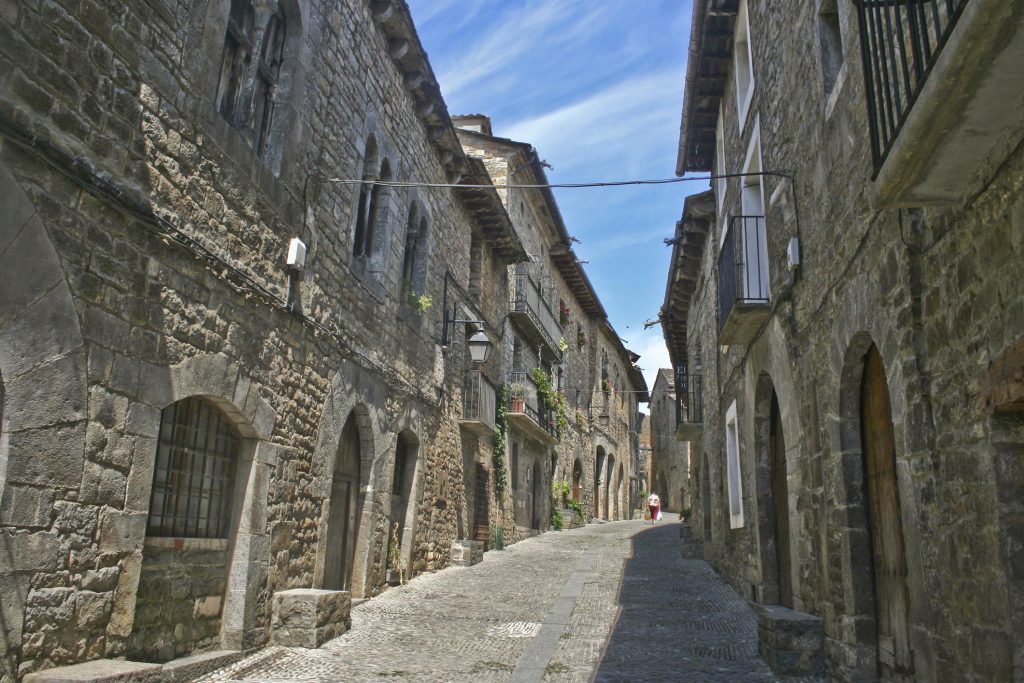
The village, which was the capital of the old Kingdom of Sobrarbe, and was later incorporated into the Kingdom of Aragon in the 11th century, constitutes a magnificent example of medieval urban development.
The historic quarter of the village of Ainsa, declared a Historic-Artistic site, is formed by a group of houses that are packed together in the most harmonious and uniform of ways, among which the slender tower of the collegiate church stands out, as well as the enormous premises of the castle, almost as big as the rest of the town. The walls that surrounded the town centuries ago remain almost intact today, the town itself being filled with monuments that bring us back to the Middle Ages.
Ronda, Málaga

This town in the Málaga region sits on either side of the Tajo del Ronda, a narrow gorge more than 150 metres deep. Its old town has been declared Property of Cultural Interest. Celts, Phoenicians, Romans and Arabs all inhabited these lands, which were reconquered by the Catholic Monarchs. The historic quarter, reminiscent of the Arab age and with a medieval layout is scattered to the south of the Guadalevín, while more modern Ronda, the part which sprang up after the 16th century, unfolds to the north of the course of this river. Several bridges unite the two halves of one of the most interesting towns on the route of the Whitewashed Villages, in the heart of the the Ronda hills, only a few kilometres from the Costa del Sol.
Albarracín, Teruel

The former capital of a Moorish kingdom (Taifa), the small town of Albarracín has preserved all its Islamic and mediaeval flavour. Its old quarter has the Property of Cultural Interest designation.
The main thing that surprises visitors who arrives at the town of Albarracín is its imposing fortified enclosure, whose perimeter is far larger than the area of the urban centre. What we see today corresponds to three different periods of construction.
The Fortress and the Andador Tower are from the 10th century. In the 11th century, the kings of Albarracín constructed the walls around the poor area of Engarrada. Finally, after the Reconquest, the Christian lords and kings of Aragon erected new sections of walls and most of the forts and towers that remain.
Sepúlveda, Segovia

Declared a Historic-Artistic Site in 1951, Sepúlveda reflects the influence of the Romanesque style in its monuments and streets, dating back to its era of greatest splendour in the 11th to 12th centuries. Sepulveda is the site of the first Romanesque church constructed in the province, El Salvador Church, dating back to 1093. It has only one nave with a semicircular apse and a tower separate from the nave. Another site worth visiting is the 12th-century Santa María de la Peña shrine, located on the outskirts of the town above one of the deepest gorges along the Duratón River.
 2
Like
Published at 7:37 PM Comments (1)
2
Like
Published at 7:37 PM Comments (1)
A Head for Heights
Saturday, February 15, 2025
Spain has some of the most spectacular trails in Europe and even some that were once considered amongst the most dangerous in the world. If you fancy a walk with a little more excitement you might just want to check out these breathtaking but vertiginous walks around Spain...here are the top 10 (in no particular order.)
1. Bejía Canal, Anaga, Tenerife
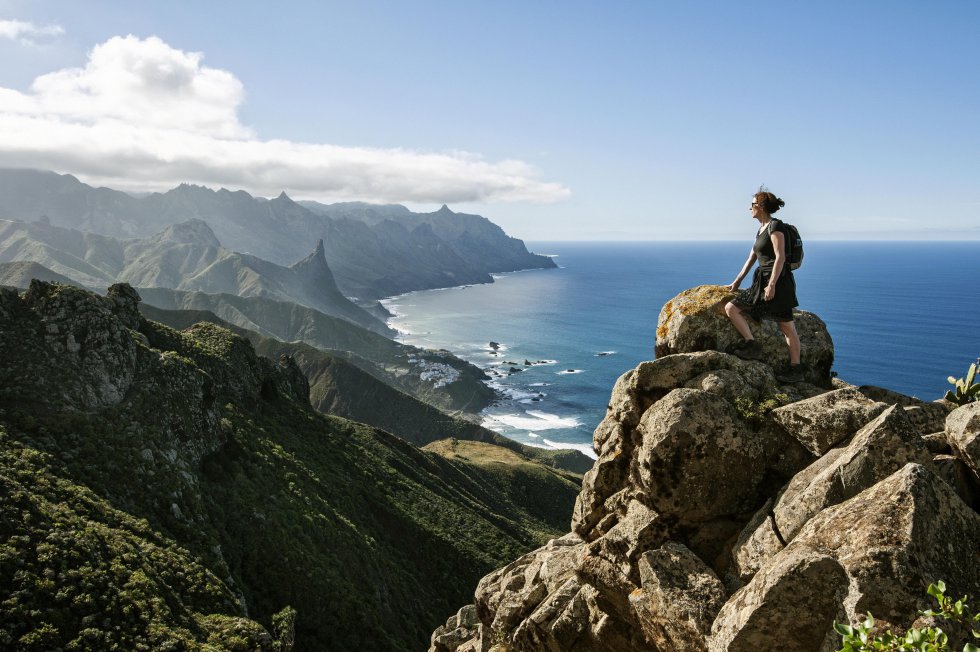
Located on Tenerife’s northeast coast, the path out of the village of Bejía, on the northern slope of the Anaga massif (above), offers plenty of photo opportunities. Moderately difficult, the trail is four kilometres long and follows the Bejía canal through the Seco ravine that eventually drops down to Punta del Hidalgo. The walk can be circular – and longer (7.5 km) – if you climb the ravine from Punta del Hidalgo and come up from the bottom of the valley to Bejía.
2. Faja de las Flores, Pyrenees, Huesca

In one of the most spectacular belts of Ordesa, there is a challenging trail across the valley that requires some rock climbing. It takes about eight hours but the effort is rewarded by breathtaking views.
3. Cañón de Añisclo, Pyrenees

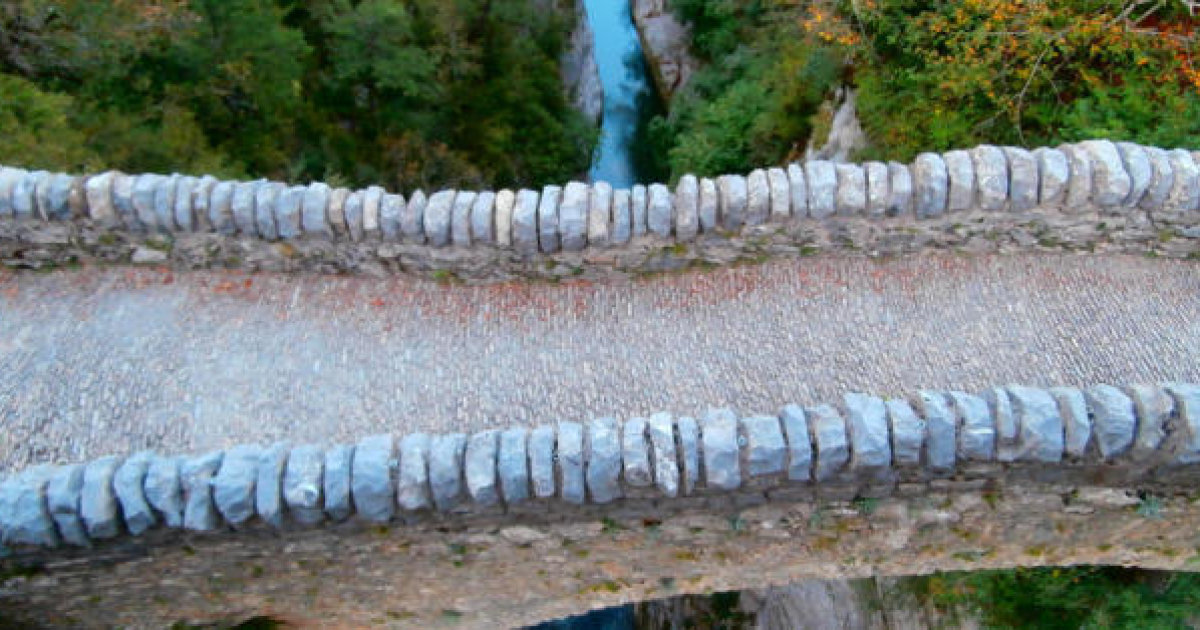
The Canyon of Añisclo, generated by the Bellós river, is oriented from north to south and extends for almost 25 kilometres, from the Circus of Añisclo - at the foot of Monte Perdido - to the confluence with the Aso valley. Its minimum altitude is 700 m, in the Fountain of the Baths; And the maximum of 3,022 m, in Punta de las Olas.
4. Cares Route, Picos de Europa, Asturias y León

Accessible and amazing, this magical 12-kilometre walk is carved into the edge of the mountainside in the Picos de Europa. Known as the Cares trail, it connects the Asturian town of Poncebos with Caín in León, offering the kind of views that have made it one of the most popular hikes in the national park. The trick is to have a friend walk from the other end so you can swap car keys midway through the hike and avoid having to trudge the 12 kilometres back to your vehicle!
5. Penya Roja, Mallorca

There are plenty of exciting and secret climbs on the peninsula of Alcudia in Mallorca, like the trail to Penya Roja from the Victoria sanctuary that hugs the cliff face and is dizzying enough to require a handrail. The highlight of this walk is the Atalaya crossing (above), a narrow 15th-century tunnel designed to protect access to the fort at the top. The climb not only leads you to the ruins of this fort but also gives you a magnificent view of the Mallorcan coastline.
6. Caminito del Rey, Málaga

For a long time, the Caminito del Rey – King’s Path – was considered one of the most dangerous trails in the world, but the construction of a brand new footbridge over the old and deteriorated trail in 2015 now allows walkers to safely cross the vertiginous 100-meter-high Gaitanes stretch over the River Guadalhorce. A real treat.
7.Cahorros de Monachil, Granada

Just minutes from the center of Granada, the Monachil River runs through a narrow gorge at the base of the Sierra Nevada massif where an exciting mountain trail – three hours long and moderate to difficult – climbs above the ravine (above), taking you to a suspension bridge that’s 63 meters long and a passageway that forces you to crouch at the part known as The Pigeons’ Cave.
8. Congosto de Mont-rebei, Lleida, and Pasarela de Montfalcó, Huesca

The most hair-raising part of this walk that takes you along the Mont-rebei gorge – 500 meters high and barely 20 meters wide – has a steel handrail to stop you falling into the abyss. Running through the gorge is the River Noguera Ribagorzana on the border between Aragon and Catalonia in the Montsec mountain range. The round trip is 14 kilometres, with the footbridge of Montfalcó providing the dramatic ending. You can hire mountain guides if needed from the Montfalcó hostal. (www.guiasdelmontsec.es).
9. Grau de Barrots, Montsant, Tarragona

The ‘graus’ that crisscross the Montsant mountain range, such as l’Escletxa (above), are narrow trails with sudden ascents. The most vertiginous one is Barrots – 5.5 kilometres of moderate to difficult hiking – which follows terraces that cling to the rock faces overlooking the Priotat vineyards.
10. Mao River Footbridge, Ourense

The last stretch of the River Mao drops 600 meters in just a few kilometres, creating a stunning series of small waterfalls before it snakes through a narrow valley. A wooden walkway built into the hillside takes you to the point where this tributary meets the River Sil. The walk is an easy two kilometres that leave from La Fábrica, an old power station that has been converted into a lodge.
 4
Like
Published at 1:38 PM Comments (0)
4
Like
Published at 1:38 PM Comments (0)
Spam post or Abuse? Please let us know
|
|